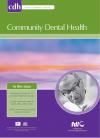Community Dental Health

- Cover Date:
- June 2008
- Print ISSN:
- 0265 539X
- Vol:
- 25
- Issue:
- 2
Measuring oral health behaviour in Flemish health care workers: an application of the Theory of Planned Behaviour
Objective This study describes the development and validation of a questionnaire to measure the determinants of oral health related behaviour in health care workers, based on the Theory of Planned Behaviour (TPB). Research design A preliminary questionnaire was drafted containing 78 self report items measuring three behaviours related to oral health (i.e. dietary habits, oral hygiene habits and dental attendance), as well as the attitudes, perceived social norms and self-efficacy for each behaviour. The questionnaire was completed by 201 health care workers for the initial validation and 966 other health care workers for a replication. Outcomes A principal component analysis with Procrustes rotation toward an a priori three component structure on the original sample yielded high congruence measures for reported dental attendance, but not for dietary habits and oral hygiene habits. Subsequent exploratory Varimax rotations and discarding of redundant items resulted in three component solutions explaining 43% of the variance in dietary habits, 57% in oral hygiene habits and 66% in dental attendance, respectively. For all three behaviours, these components corresponded to the dimensions of the TPB. Internal consistency of the scales was satisfactory, with Chronbach’s alpha’s ranging from 0.51 to 0.87. Scale scores accounted for a significant proportion of the variance in the intention to avoid sweet snacks, to brush teeth, and to attend dental check-ups, and of the frequency of consumption of sweet drinks and frequency of brushing. A confirmatory factor analysis on the larger sample of 966 health care workers provided excellent goodness of fit indices, confirming the construct validity of the scales.
Key words: behaviour, determinants, health care workers, oral health, questionnaire
- Article Price
- £15.00
- Institution Article Price
- £
- Page Start
- 107
- Page End
- 114
- Authors
- A. Defranc, S. Van den Broucke, R. Leroy, K. Hoppenbrouwers, E. Lesaffre, L. Martens, M. Debyser, D. Declerck
Articles from this issue
- Title
- Pg. Start
- Pg. End
- Editotial - Do we let children’s teeth decay just because some people object to topping up the natural fluoride that’s already in our water?
- 66
- 69
- Dental caries rates in primary teeth in 2002, and caries surveillance trends 1981-2002, in a South African city.
- 79
- 83
- Individual and maternal determinants of self–reported dental health among Turkish school children aged 10-12 years.
- 84
- 88
- Comparison of ranking dental status using the Significant Caries Index and the Significant Filled and Sound-Teeth Index
- 103
- 106
- Measuring oral health behaviour in Flemish health care workers: an application of the Theory of Planned Behaviour
- 107
- 114
